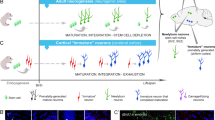Abstract
(1) Neurogenesis driven by neural stem cells (NSCs) is regulated by physiological and pathological factors. Melatonin (MT) has profound neurotrophic and neuroprotective effects. Hence, we studied the role of MT in regulating the viability and differentiation of NSCs derived from rat ventral midbrain. (2) NSCs were isolated from the rat ventral midbrain. The viability of NSCs was determined by 3-(4,5-dimethylthiazol-2-yl)-5-(3-carboxymethoxyphenyl)-2-(4-ulfophenyl)-2H-tetrazolium assay. The differentiation of NSCs was examined by analyzing the expression of the neural markers, MT receptors, brain derived neurotropic factor (BDNF) and glial cell line-derived neurotrophic factor (GDNF) with semi-quantitative RT-PCR, immunofluorescence cytochemistry, and Western blot. (3) Our results showed that MT could promote the viability of NSCs. In addition, MT could significantly elevate the mRNA and protein levels of tyroxine hydroxylase (TH), a marker of dopaminergic neurons, and decrease the expression of the astrocytes maker glial fibrillary acidic protein (GFAP). MT also increased the production of BDNF and GDNF in the cultured NSCs. Meanwhile, we first found that two subtypes of MT receptors, MT1 and MT2, were expressed in the ventral midbrain NSCs. (4) These results demonstrated that MT could induce NSCs to differentiate into dopaminergic neurons and decrease astrocyte production. These findings also suggest that MT could offer a beneficial tool in guiding directional differentiation of NSCs.






Similar content being viewed by others
References
Armstrong KJ, Niles LP (2002) Induction of GDNF mRNA expression by melatonin in rat C6 glioma cells. Neuroreport 13:473–475
Bao JF, Wu RG, Zhang XP, Song Y, Li CL (2005) Melatonin attenuates 1-methyl-4-phenylpyridinium-induced PC12 cell death. Acta Pharmacol Sin 26:117–123
Chuang JI, Chen TH (2004) Effect of melatonin on temporal changes of reactive oxygen species and glutathione after MPP+ treatment in human astrocytoma U373MG cells. J Pineal Res 36:117–125
Cui X, Zuo P, Zhang Q, Li X, Hu Y, Long J, Packer L, Liu J (2006) Chronic systemic D-galactose exposure induces memory loss, neurodegeneration, and oxidative damage in mice: protective effects of R-alpha-lipoic acid. J Neurosci Res 84:647–654
Feng Z, Zhang JT (2004) Melatonin reduces amyloid beta-induced apoptosis in pheochromocytoma (PC12) cells. J Pineal Res 37:257–266
Kalivendi SV, Kotamraju S, Cunningham S, Shang T, Hillard CJ, Kalyanaraman B (2003) 1-Methyl-4-phenylpyridinium (MPP+)-induced apoptosis and mitochondrial oxidant generation: role of transferrin-receptor-dependent iron and hydrogen peroxide. Biochem J 371:151–164
Kim MJ, Kim HK, Kim BS, Yim SV (2004) Melatonin increases cell proliferation in the dentate gyrus of maternally separated rats. J Pineal Res 37:193–197
Lee SH, Chun W, Kong PJ, Han JA, Cho BP, Kwon OY, Lee HJ, Kim SS (2006) Sustained activation of Akt by melatonin contributes to the protection against kainic acid-induced neuronal death in hippocampus. J Pineal Res 40:79–85
Martin V, Sainz RM, Antolin I, Mayo JC, Herrera F, Rodriguez C (2002) Several antioxidant pathways are involved in astrocyte protection by melatonin. J Pineal Res 33:204–212
Nakatomi H, Kuriu T, Okabe S, Yamamoto S, Hatano O, Kawahara N, Tamura A, Kirino T, Nakafuku M (2002) Regeneration of hippocampal pyramidal neurons after ischemic brain injury by recruitment of endogenous neural progenitors. Cell 110:429–441
Niles LP, Armstrong KJ, Rincon Castro LM, Dao CV, Sharma R, McMillan CR, Doering LC, Kirkham DL (2004) Neural stem cells express melatonin receptors and neurotrophic factors: colocalization of the MT1 receptor with neuronal and glial markers. BMC Neurosci 5:41
Scharfman H, Goodman J, Macleod A, Phani S, Antonelli C, Croll S (2005) Increased neurogenesis and the ectopic granule cells after intrahippocampal BDNF infusion in adult rats. Exp Neurol 192:348–356
Taupin P, Gage FH (2002) Adult neurogenesis and neural stem cells of the central nervous system in mammals. J Neurosci Res 69:745–749
Tunez I, Montilla P, Del Carmen Munoz M, Feijoo M, Salcedo M (2004) Protective effect of melatonin on 3-nitropropionic acid-induced oxidative stress in synaptosomes in an animal model of Huntington’s disease. J Pineal Res 37:252–256
von Gall C, Stehle JH, Weaver DR (2002) Mammalian melatonin receptors: molecular biology and signal transduction. Cell Tissue Res 309:151–162
Yamamoto HA, Mohanan PV (2003) In vivo and in vitro effects of melatonin or ganglioside GT1B on L-cysteine-induced brain mitochondrial DNA damage in mice. Toxicol Sci 73:416–422
Zhang Q, Huang Y, Li X, Cui X, Zuo P, Li J (2005) GM1 ganglioside prevented the decline of hippocampal neurogenesis associated with D-galactose. Neuroreport 16:1297–1301
Acknowledgment
This work was supported by a grant from “973” Basic Research Funding Scheme of China (2007CB507400).
Author information
Authors and Affiliations
Corresponding author
Rights and permissions
About this article
Cite this article
Kong, X., Li, X., Cai, Z. et al. Melatonin Regulates the Viability and Differentiation of Rat Midbrain Neural Stem Cells. Cell Mol Neurobiol 28, 569–579 (2008). https://doi.org/10.1007/s10571-007-9212-7
Received:
Accepted:
Published:
Issue Date:
DOI: https://doi.org/10.1007/s10571-007-9212-7




